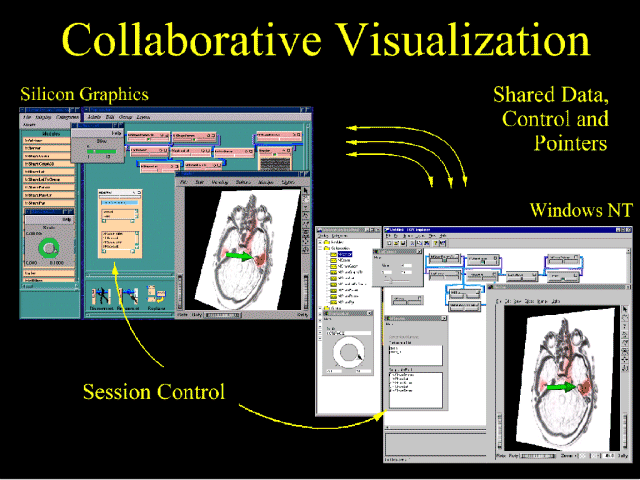
by Jason Wood, University of Leeds
The COVISA project was set up to look at the area of multi-user collaboration within the field of scientific data visualization. It sought to investigate models and architectures for collaboration between geographically separated colleagues and to develop prototype software solutions. The decision was taken to investigate how to extend the current visualization tools for collaboration, rather than developing a completely new 'in house' visualization system. The class of visualization systems targeted were the Modular Visualization Environments (MVEs) due to their extensibility and open architecture. The prototype systems developed were built around IRIS Explorer.
The results of this project were a reference model for collaborative visualization, an architecture for extending the MVE class of system and a prototype system developed around IRIS Explorer. This prototype consisted of a toolkit of modules that allowed the user to join a collaborative session, share data and control of modules between colleagues, and remotely construct maps in the map editors of their collaborators. These modules worked within IRIS Explorer exactly as any other modules so minimising the effort required to achieve collaboration between current users of this system. The modules work not only in IRIS Explorer's dynamic map building mode, but can also be bound into visualization applications built using IRIS Explorer to give collaborative visualization applications.
Since the completion of this research project, NAG has funded continued research and development of the COVISA toolkit. The original module set has been improved and extended with the addition of new collaborative modules and improved session control. In addition an application programmer interface (API) has been developed to allow users to construct their own collaborative visualization modules that fit within the COVISA framework. This new module set and API have been ported from the original Silicon Graphics platform to Windows NT to allow platform independent collaboration on the construction of a visualization application.
The technology from COVISA has been incorporated into the latest version of IRIS Explorer, which is soon to be available from NAG. See the article in this issue for more information about IRIS Explorer 4.0.
COVISA was an EPSRC funded project under the ROPA initiative conducted in the School of Computer Studies at the University of Leeds. The project was undertaken by Ken Brodlie, Helen Wright and Jason Wood.

Collaboration between geographically separate IRIS Explorer sessions in COVISA. This shows a user on an SGI machine collaborating with their colleague on a machine running Windows NT. However, the system supports any number of users, and will be available as part of IRIS Explorer 4.0 for all supported platforms. A module running in each session establishes shared control of the sessions, allowing data, map fragments and connection information to be passed between them. Here, two doctors are collaborating on the analysis of CAT data, displayed in the Render modules. A representation of a pointer icon (the green arrow) has been generated using the Pointer module; this is then shared between the sessions to allow each doctor to indicate points of interest in the scene